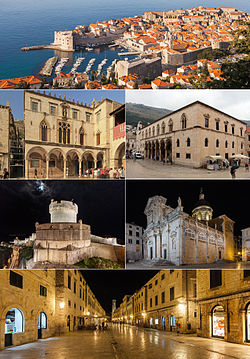Dubrovnik
| Dubrovnik | |||
|---|---|---|---|
| City | |||
| City of Dubrovnik Grad Dubrovnik |
|||

Top: Old City of Dubrovnik, Second left: Sponza Palace, Second right: Rector's Palace, Third left: city walls, Third right: Dubrovnik Cathedral, Bottom: Stradun, the city's main street
|
|||
|
|||
| Nickname(s): "Croatian Athens", "Pearl of the Adriatic", "Thesaurum mundi" | |||
| The location of Dubrovnik within Croatia | |||
| Coordinates: 42°38′25″N 18°06′30″E / 42.64028°N 18.10833°ECoordinates: 42°38′25″N 18°06′30″E / 42.64028°N 18.10833°E | |||
| Country |
|
||
| County |
|
||
| Government | |||
| • Type | Mayor-Council | ||
| • Mayor | Andro Vlahušić (HNS) | ||
| • City Council |
Four clubs
|
||
| Area | |||
| • City | 21.35 km2 (8.24 sq mi) | ||
| Elevation | 3 m (10 ft) | ||
| Population (2011) | |||
| • City | 42,615 | ||
| • Density | 2,000/km2 (5,200/sq mi) | ||
| • Urban | 28,434 | ||
| • Metro | 65,808 | ||
| Time zone | CET (UTC+1) | ||
| • Summer (DST) | CEST (UTC+2) | ||
| Postal code | 20000 | ||
| Area code(s) | 020 | ||
| Vehicle registration | DU | ||
| Website | http://www.dubrovnik.hr/ | ||
| Old City of Dubrovnik | |
|---|---|
|
Native name Croatian: Stari grad Dubrovnik |
|

The Old Harbour at Dubrovnik
|
|
| Location |
Dubrovnik-Neretva County, |
| Type | Cultural |
| Criteria | i, iii, iv |
| Designated | 1979 (3rd Session) |
| Reference no. | 95 |
| Europe and North America | |
| Extension | 1994 |
| Endangered | 1991–1998 |
| Official name: Stari grad Dubrovnik | |
Dubrovnik ([dǔbroːʋniːk]; also known by other names) is a Croatian city on the Adriatic Sea, in the region of Dalmatia. It is one of the most prominent tourist destinations in the Mediterranean Sea, a seaport and the centre of Dubrovnik-Neretva County. Its total population is 42,615 (census 2011). In 1979, the city of Dubrovnik joined the UNESCO list of World Heritage Sites.
The prosperity of the city was historically based on maritime trade; as the capital of the maritime Republic of Ragusa, it achieved a high level of development, particularly during the 15th and 16th centuries, as it became notable for its wealth and skilled diplomacy.
Although it was demilitarised in the 1970s to protect it from war, in 1991, after the break-up of Yugoslavia, it was besieged by the Serb and Montenegrin soldiers gathered in the Yugoslav People's Army (JNA) for seven months and suffered significant damage from shelling.
The town's name is derived from dubrava, which means "oak grove". Dub means "oak" in Croatian.
The historical Latin and Dalmatian name of Dubrovnik is Ragusa (pronounced [raˈɡu.sa]), or Ragusium in older form. The Latin, Italian and Dalmatian name Ragusa derives its name from Lausa (from the Greek ξαυ: xau, "precipice"); it was later altered in Rausium (Appendini says that until after AD 1100, the sea passed over the site of modern Ragusa, if so, it could only have been over the Placa or Stradun) or Rausia (even Lavusa, Labusa, Raugia and Rachusa) and finally into Ragusa. It was called Ῥαούσιν (Rhaousin) in Byzantine Greek in 10th Century, according to D.A.I. It might also be related to the Albanian word rrush meaning grapes. The current name was officially adopted in 1918 after the fall of the Austro-Hungarian Empire, but was in use from the Middle Ages. It is also referred to as Dubrovnik in the Charter of Ban Kulin in 1189. See also: Other names of Dubrovnik.
...
Wikipedia



